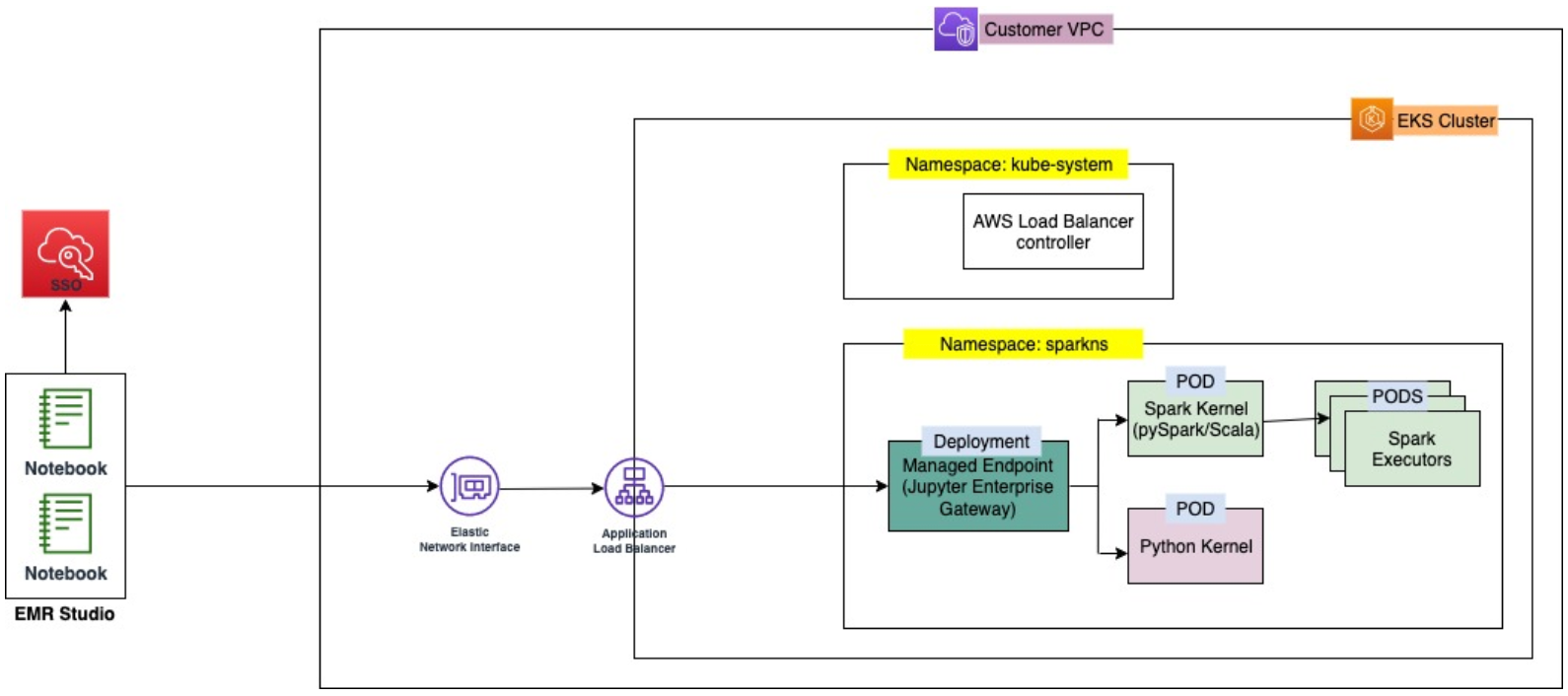Overview of interactive endpoints
An interactive endpoint provides the capability for interactive clients like Amazon EMR Studio to connect to Amazon EMR on EKS clusters to run interactive workloads. The interactive endpoint is backed by a Jupyter Enterprise Gateway that provides the remote kernel lifecycle management capability that interactive clients need. Kernels are language-specific processes that interact with the Jupyter-based Amazon EMR Studio client to run interactive workloads.
Interactive endpoints support the following kernels:
-
Python 3
-
PySpark on Kubernetes
-
Apache Spark with Scala
Note
Amazon EMR on EKS pricing applies for the interactive endpoints and kernels. For more
information, see the Amazon EMR on EKS pricing
page
The following entities are required for EMR Studio to connect with Amazon EMR on EKS.
-
Amazon EMR on EKS virtual cluster – A virtual cluster is a Kubernetes namespace that you register Amazon EMR with. Amazon EMR uses virtual clusters to run jobs and host endpoints. You can back multiple virtual clusters with the same physical cluster. However, each virtual cluster maps to one namespace on an Amazon EKS cluster. Virtual clusters don't create any active resources that contribute to your bill or that require lifecycle management outside the service.
-
Amazon EMR on EKS interactive endpoint – An interactive endpoint is an HTTPS endpoint to which EMR Studio users can connect a workspace. You can only access the HTTPS endpoints from your EMR Studio, and you create them in a private subnet of the Amazon Virtual Private Cloud (Amazon VPC) for your Amazon EKS cluster.
The Python, PySpark, and Spark Scala kernels use the permissions defined in your Amazon EMR on EKS job execution role to invoke other Amazon Web Services services. All kernels and users that connect to the interactive endpoint utilize the role that you specified when you created the endpoint. We recommend that you create separate endpoints for different users, and that the users have different Amazon Identity and Access Management (IAM) roles.
-
Amazon Application Load Balancer controller – The Amazon Application Load Balancer controller manages Elastic Load Balancing for an Amazon EKS Kubernetes cluster. The controller provisions an Application Load Balancer (ALB) when you create a Kubernetes Ingress resource. An ALB exposes a Kubernetes service, such as an interactive endpoint, outside of the Amazon EKS cluster but within the same Amazon VPC. When you create an interactive endpoint, an Ingress resource is also deployed that exposes the interactive endpoint by means of the ALB for interactive clients to connect to. You only need to install one Amazon Application Load Balancer controller for each Amazon EKS cluster.
The following diagram depicts the interactive endpoints architecture in Amazon EMR on EKS. An
Amazon EKS cluster comprises the compute to run the analytic workloads, and the interactive endpoint. The
Application Load Balancer controller runs in the kube-system namespace; the
workloads and interactive endpoints run in the namespace that you specify when you create the virtual
cluster. When you create an interactive endpoint, the Amazon EMR on EKS control plane creates
the interactive endpoint deployment in the Amazon EKS cluster. Additionally, an instance of the
application load balancer ingress is created by the Amazon load balancer controller. The
application load balancer provides the external interface for clients like EMR Studio to
connect to the Amazon EMR cluster and run interactive workloads.
